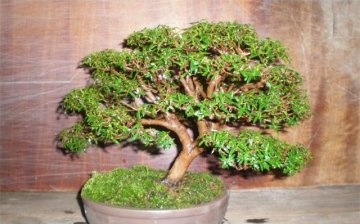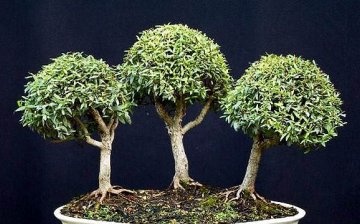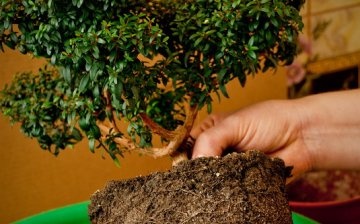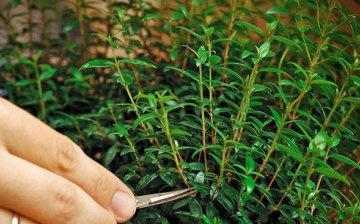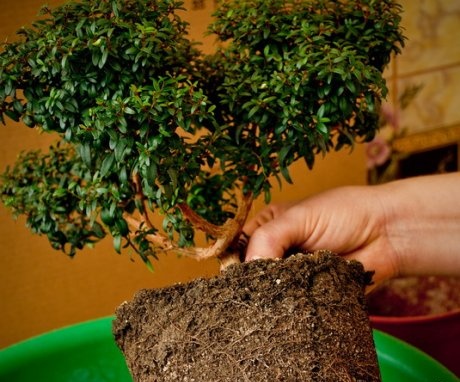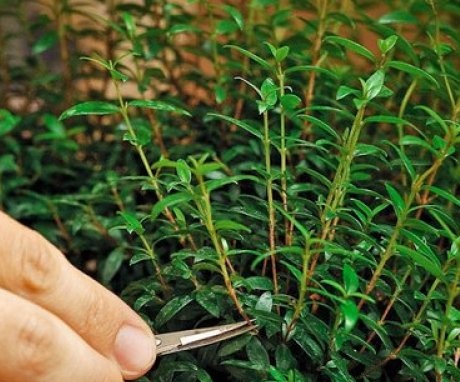Bonsai myrtle: features of care and reproduction
Bonsai myrtle is a small copy of a large tropical plant. It is not difficult to grow it at home, it will be grateful for regular watering and spraying.
Content:
Description of bonsai myrtle
Common myrtle - evergreen indoor shrub plant... It came to us from the Mediterranean. Under natural conditions, it grows up to 3 meters, the leaves are small, dark green. A particularly beautiful plant during the flowering period, when it is covered with small white flowers.
There are several types of myrtle and many varieties, but only common myrtle and its variety are small-leaved myrtle are used in home floriculture. The first is popularly called myrtle communis, as its Latin name is read.
Myrtle - refers to bonsai. That is, these are miniature copies of real trees.
This is a real pride for every home, bonsai are very much appreciated, so getting their cuttings is not so easy and expensive. Myrtle belongs to the Myrtle family, its leaves contain essential oils, and therefore it is widely used in folk and traditional medicine, in perfumery and cosmetology.
Features of the plant:
- Myrtle is best suited to sunny but not humid locations.
- When growing a plant at home in a pot, you can expect its height to be no more than 90 cm
- If myrtle is grown in the garden, then it must be moved indoors for the winter.
- Myrtle grows quickly and widely; its stems are densely packed with shiny narrow leaves no more than 5 cm long.
- The leaves are small, leathery, opposite.
- Close up, the plant emits a pleasant aroma.
- The flowering period for myrtle begins in early summer.
- The flowers are small, up to 2 cm in diameter, yellow stamens peep out of the white flower.
- Despite the presence of essential oils in myrtle leaves, allergy sufferers may not be afraid, there is usually no negative reaction to volatile secretions.
- Myrtle fruits taste not very pleasant, however, very useful.
- Dried berries and dried leaves can be added to food.
- Fruits begin to appear in early summer, along with flowering.
- House pollination happens with brushes.
If the fruits are ripe, then seeds can be removed from them for propagation.
In some countries there is a tradition - to give a wreath of blooming myrtle for a wedding, it is a symbol of fertility and purity. If a myrtle flower is placed at home, then it will not only decorate the room, but also purify the air.
Growing and caring
Bonsai myrtle at home placed on a light windowsill, on any side except the north. It is good if the window near which he stands is often open. The plant is not afraid of drafts and loves coolness. But if the temperature drops below -20 degrees, then the frosty air can destroy the leaves. If a stream of fresh air gets on the plant, then phytoncides will be brought into the room, this is especially useful for a children's room.
Plant care tips:
- Achieving flowering of a plant is possible only with a sufficient amount of sunlight. In order for the berries to appear, myrtle needs pollination, insects can do this, or the person himself.
- If the room is warm in winter, then the myrtle leaves should be sprayed and often watered evenly. You do not need to put the pot close to the batteries, in order to avoid drying out the soil.To prevent the roots from rotting, the water from the sump must be drained immediately.
- The natural conditions for myrtle are a subtropical climate, therefore, it must endure winter in a frost-free place, the optimum temperature is not lower than +5 degrees, although it will be able to endure zero temperature.
- It is important to choose a suitable soil, the flower may die from an excess of lime, so you need to choose a slightly acidic soil. If the land is peaty, then it is diluted with turf and sand.
- All summer, when the weather is hot, the plant must be sprayed, it is best to wash it under the shower.
It is not necessary to transplant bonsai myrtle often, once every few years is enough, this is done in the spring. The pot is chosen not based on the shrub plant, but on the degree of drying out of the soil: if you water the myrtle in the morning, by the evening the soil should remain moist.
Particular attention is paid to the formation of the myrtle bush:
- In order for the crown to be thick, the plant must be pinched.
- Pruning can be done when the plant is still very young, since it begins to branch early.
- From myrtle, you can form a miniature tree, and a dense shrub with a spherical or pyramidal crown.
Landscape designers and just amateur flower growers create whole green sculptures from myrtle.
Not worth it forget about feeding myrtle. For the roots to grow healthy, they need a sufficient amount of calcium. During the period of active growth, fertilizer for bonsai is applied every two weeks. If flowering is expected, it is sufficient to feed the plant once a month.
Reproduction and possible pests
Reproduction of myrtle carried out by cuttings... They begin to harvest them in the summer, from July to August. It is also not difficult to propagate by seeds, but there is a risk of losing the characteristics of the variety.
Propagation by cuttings:
- Cuttings are harvested with a length of 8 cm, there should be several leaves and a heel on it. For rooting cuttings, a special mixture is prepared, consisting of peat and sand in equal proportions. Cuttings are placed along the edge of the pot.
- The pot with cuttings is covered with plastic wrap with several holes for the passage of air. Now it is transferred to partial shade, where the air temperature reaches 20 degrees.
- Rooting takes a long time, you need to wait a month or two. It is possible to understand that the rooting process began after the appearance of new shoots, after which the shoots can be transferred to the usual conditions for myrtle without a film.
- With the onset of spring, cuttings are transplanted into separate pots, up to 10 cm in diameter. The soil is prepared from peat soil with perlite. It is best to keep the temperature cool before the onset of vegetation.
Myrtle will react negatively to improper care, if the leaves begin to fall off, then you need to correct the watering: reduce or increase. Maybe the lack of sunlight had this effect.
Myrtle is susceptible to such pests:
- Shield.
- Felter.
- Whitefly.
- Mealybug.
- Thrips.
- Aphid.
- Spider mite.
To eliminate whitefly, thrips, mealybug or a scabbard, you need to spray the leaves with Aktara's solution once a week, do this 4 times. To achieve the best result, you can add Actellic processing. Aktara also eliminates aphids, 2 treatments will be enough.
Aphids will disappear if you transfer the plant to the sun, spray it periodically and moisten the soil in time.
The mealybug and scabbard can be removed with an ordinary cotton swab. To completely destroy the parasites, the stick is moistened in an alcoholic infusion.
Bonsai myrtle requires compliance with some rules of care. To obtain highly decorative plant, the bush needs to be shaped.
More information can be found in the video.



